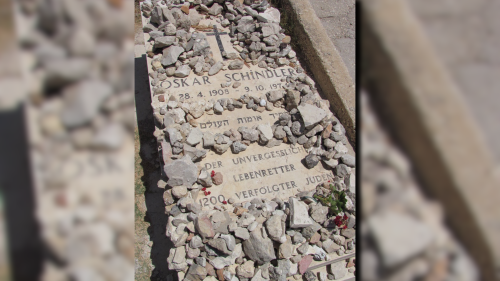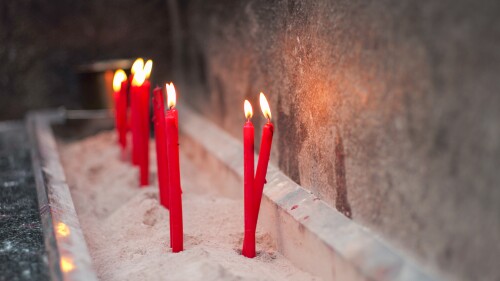Originally published under the title “The Widespread Desecration of Christian Graves.”
In May 2004, vandals in Gaza desecrated 32 graves of soldiers killed in World War I, including those from Britain and India. |
Although the persecution by members of some religions of live human beings, such as Jews and Christians, is certainly more monstrous, attacks on inanimate religious symbols possibly give an even clearer indication of a deadly hate borne for the “other.”
Consider, for instance, extremists desecrating and destroying Christian cemeteries and their crosses. While the act itself is largely “symbolic” -- in that no living person gets hurt -- it is also reflective of a committed hatred that transcends, say, responding to a physical threat. While the persecution of a Christian can be motivated by particular circumstances -- conflicts, sexual attraction, convenience, gain, and so on -- attacks on inanimate symbols would seem to reflect a hatred for Christianity and its followers that needs no “reason” and seemingly gains nothing.
While anti-Christian violence can be self-interested, attacks on inanimate symbols seemingly gain nothing. |
From one end of the Middle Eastern world to the other -- and in Arab, African and Asian nations, and increasingly in the West -- this sort of hate has become a regular occurrence, seemingly “normalized.” A brief list follows, ordered by desecrations committed by formal terrorists, such as ISIS, al-Qaeda and similar organizations; informal terrorists, such as religious mobs; and theocratic governments.
Libya: In March 2012, a video of an extremist mob attacking a Commonwealth cemetery near Benghazi, where WWII British officers were buried, appeared on the Internet. As the vandals kick down and destroy headstones with crosses on them, the man videotaping them urges them to “Break the cross of the dogs!” while he and others cry “Allahu Akbar!” At one point, while he tells an overly zealous desecrater to “calm down,” he chuckles. When another member of the mob complains that he is unable to kick down a particular stone, and wonders if it is because “this soldier must have been good to his parents,” the man doing the videotaping replies, “Come on, they are all dogs, who cares?” Finally the mob congregates around the huge Cross of Sacrifice, the cemetery’s cenotaph monument, and starts hammering at it, to more cries of “Allahu Akbar.”
A similar incident occurred in Libya on June 3, 2015: People described by witnesses as extremists destroyed crosses and tombstones and dug up graves in the old Christian section of Tripoli.
Iraq: In April 2015, a group of men affiliated with ISIS desecrated Mosul’s oldest Christian cemetery, dedicated to St. Thomas the Apostle.
An ISIS militant destroys tombstones at Mosul’s oldest Christian cemetery in April 2015. |
ISIS published pictures of its followers using sledgehammers to destroy gravestones and efface the crosses carved on them as documentary evidence of their campaign to “eradicate mushrik [pagan] symbols.”
In November, 2016, a human rights group published photos from the Christian cemetery of Qarqoosh, which was also vandalized by ISIS-supporters. The desecraters also opened coffins and despoiled the dead; one picture shows the snapped off skull of a corpse, who had presumably formerly been resting-in-peace, with crosses hurled around it on the ground.
Syria: The Islamic State released an online video on May 16, 2016, showing an ISIS fighter desecrating Christian graves at the Deir ez-Zor cemetery.
Although so-called “mainstream media” reported some of the desecrations above -- probably mostly because the Islamic State had already publicized them -- they rarely report that “everyday” extremists also engage in this macabre practice. A few examples follow:
Indonesia: In April 2019, there was “a rash of desecrations directed at Christian graves in the city of Yogyakarta, a spree some local residents believe was a targeted act of intolerance rather than random vandalism.” A few months earlier, a number of crosses and gravestones were damaged, apparently by a hammer, in what has long been touted as the world’s most “moderate” nation.
Pakistan: In May 2019, near Lahore, “38 Christians graves were desecrated... In addition to desecrating the graves, the unknown assailants also defaced several crosses fixed to the graves.” A local Christian said the incident “shows that some religious fanatics have their roots in the neighborhood and want to seed religious hatred in the mindsets of the young generation which is alarming.”
Algeria: In September, 2018, over 30 Christian graves were desecrated at La Reunion War Cemetery, one of the few Christian cemeteries remaining in the Muslim nation:
The graves were ransacked and tombstones smashed. Investigators believe that religious motives are at play. While the government is pursuing an investigation, the desecration of these graves come [sic] at a time when the Algerian authorities have increasingly harassed the church. During the past year, a number of churches have closed by authorities ...
Local witnesses said that some gravestones were completely smashed, and some crosses were broken... Flowerpots and other stone markers were also broken. It seems that perpetrators used a heavy tool to do the damage.
Crucifixes and other stone objects were taken away from their graves in the Christian cemeteries of Saint Lazarus of Bethany and Bel Air, by individuals who have not yet been identified.
Iran: In April 2012, “a 200-year old Christian cemetery in Kerman province was completely demolished” by authorities in their bid “to destroy historical Christian monuments [and] to totally wipe the Christian heritage from the face of Iran.”
A few months earlier, in February 2012, the historical graveyard of English Christians in Bushehr, which was also used by the Armenian community, was reported as being in complete disarray -- “all the crosses on graves are broken,” according to the report, which added:
For a long time, the graveyard has been intentionally overlooked by state authorities of Bushehr, because it houses the bodies of English veterans. This disregard continued to the extent that in 2003, the tourism organization of Iran built a stone wall around the graveyard and prevented visitors from entering.
Tunisia: In May 2012, after the Russian ambassador in Tunis requested that the nation’s Ministry of Interior “protect” the Orthodox Church of Tunis -- the cross of which had recently been targeted by Salafi Muslims -- both the Christian cemetery located behind the church and the Russian school were vandalized. The cemetery’s crosses were destroyed, while the walls of the school and religious frescoes were smeared with fecal matter (as took place recently in France).
As the number of newcomers in Western nations grows, the same practices that occur in the nations from which they came -- such as the desecration of Christian cemeteries -- grow with them.
Consider France. In April 2015, 215 Christian gravestones and crosses in the cemetery of Saint-Roch de Castres (Tarn) were damaged and desecrated (pictures here). According to the case prosecutor, the accused was seen dressed in traditional Middle Eastern attire; he repeats “prayers over and over, drools and cannot be communicated with: his condition has been declared incompatible with preliminary detention.” He was hospitalized on the assumption that he is “mentally unbalanced.”
Sometimes minorities in the West express their animosity in less direct ways. After newcomers in Germany were granted their own section at a cemetery, and after being allowed to conduct their religious ceremonies, they began demanding that Christian symbols and crosses in the rest of the cemetery be removed or covered up while their funerals were taking place.
Recently, European nations are taking preemptive measures to forestall potential anger emanating from religion. From Italy, it was reported in April 2019, “crosses on graves in an Italian cemetery in Pieve di Cento have been covered with black cloth so as not to offend those who may come from another religion.” The report adds:
The cemetery, which is located in Bologna in a town of around 7,000 people, has also installed motorized blackout curtains in a local chapel following renovations to hide Roman Catholic symbols during ceremonies involving other denominations.
Raymond Ibrahim is a Judith Friedman Rosen Fellow at the Middle East Forum. The above account is excerpted from Ibrahim’s Sword and Scimitar: Fourteen Centuries of War between Islam and the West.









